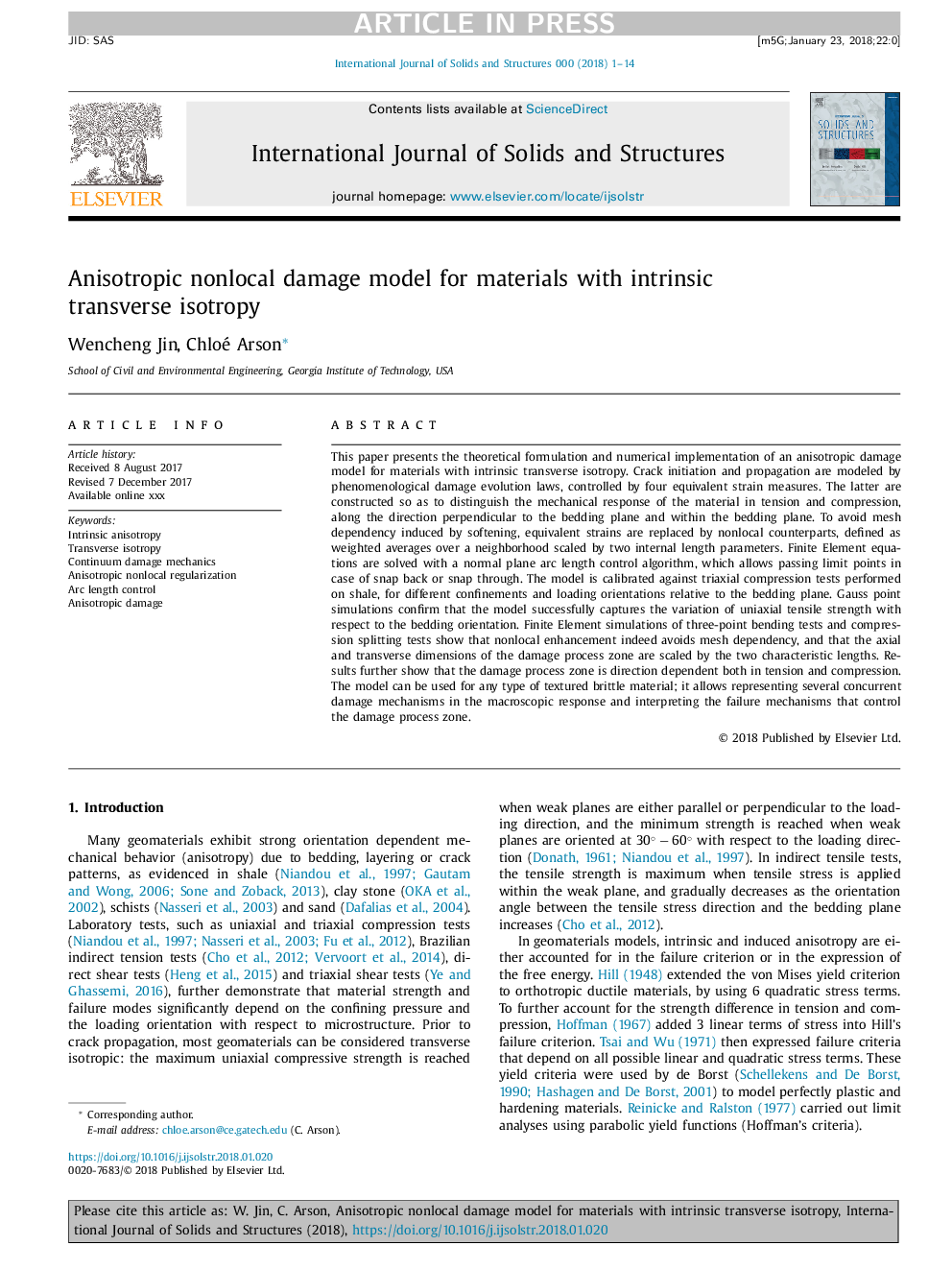| کد مقاله | کد نشریه | سال انتشار | مقاله انگلیسی | نسخه تمام متن |
|---|---|---|---|---|
| 6748332 | 1430169 | 2018 | 14 صفحه PDF | دانلود رایگان |
عنوان انگلیسی مقاله ISI
Anisotropic nonlocal damage model for materials with intrinsic transverse isotropy
ترجمه فارسی عنوان
مدل آسیب غیر انحصاری غیر محلی برای مواد با ایزوتراپی عرضی درونی
دانلود مقاله + سفارش ترجمه
دانلود مقاله ISI انگلیسی
رایگان برای ایرانیان
کلمات کلیدی
ترجمه چکیده
این مقاله ارائه فرمول نظری و پیاده سازی عددی از یک مدل خسارت بی نظیر برای مواد با ایزوتراپی عرضی درونی است. آغاز و تکثیر ترک ها به وسیله قوانین تکاملی پدیده ای آسیب دیده، که توسط چهار معیار سوق معیار کنترل می شود، مدل می شود. اینها به گونه ای ساخته شده اند که واکنش مکانیکی مواد را در کشش و فشرده سازی، در امتداد جهت عمود بر سطح هواپیما و درون سطح ملافه، متمایز می سازند. برای جلوگیری از وابستگی مش، ناشی از نرم شدن، سویه های معادل با همتاهای غیرمستقیم جایگزین می شوند که به صورت میانگین وزنی در یک محدوده اندازه گیری شده توسط دو پارامتر طول داخلی تعریف می شوند. معادلات عنصر محدود با الگوریتم کنترل طول کنترل قوس هواپیما نرمال حل می شود که اجازه می دهد تا حد مجاز در صورت ضربه زدن به عقب یا ضربه محکم و ناگهانی از طریق آن عبور کند. این مدل بر روی تست های فشرده سازی سه تایی بر روی شیل، برای محدوده های مختلف و جهت گیری بارگیری نسبت به هواپیما بستگی دارد. شبیه سازی نقطه گاوس تایید می کند که مدل با موفقیت تغییرات قدرت کششی یکسانی را با توجه به جهت گیری بستر بسته بندی می کند. شبیه سازی عنصر محدود از آزمون های خمش سه نقطه و تست تقسیم فشرده نشان می دهد که افزایش غیرمعمول در واقع از وابستگی به شبکه جلوگیری می کند و ابعاد محوری و عرضی منطقه فرآیند آسیب توسط دو طول مشخصه مقیاس می شود. نتایج بیشتر نشان می دهد که منطقه فرایند آسیب به جهت هر دو در تنش و فشرده سازی است. این مدل را می توان برای هر نوع مواد شکننده بافت استفاده کرد. این اجازه می دهد تا چندین مکانیسم آسیب همزمان را در پاسخ ماکروسکوپیک نشان دهد و مکانیسم های شکست را کنترل کند که منطقه ی روند آسیب را کنترل می کند.
موضوعات مرتبط
مهندسی و علوم پایه
سایر رشته های مهندسی
مهندسی عمران و سازه
چکیده انگلیسی
This paper presents the theoretical formulation and numerical implementation of an anisotropic damage model for materials with intrinsic transverse isotropy. Crack initiation and propagation are modeled by phenomenological damage evolution laws, controlled by four equivalent strain measures. The latter are constructed so as to distinguish the mechanical response of the material in tension and compression, along the direction perpendicular to the bedding plane and within the bedding plane. To avoid mesh dependency induced by softening, equivalent strains are replaced by nonlocal counterparts, defined as weighted averages over a neighborhood scaled by two internal length parameters. Finite Element equations are solved with a normal plane arc length control algorithm, which allows passing limit points in case of snap back or snap through. The model is calibrated against triaxial compression tests performed on shale, for different confinements and loading orientations relative to the bedding plane. Gauss point simulations confirm that the model successfully captures the variation of uniaxial tensile strength with respect to the bedding orientation. Finite Element simulations of three-point bending tests and compression splitting tests show that nonlocal enhancement indeed avoids mesh dependency, and that the axial and transverse dimensions of the damage process zone are scaled by the two characteristic lengths. Results further show that the damage process zone is direction dependent both in tension and compression. The model can be used for any type of textured brittle material; it allows representing several concurrent damage mechanisms in the macroscopic response and interpreting the failure mechanisms that control the damage process zone.
ناشر
Database: Elsevier - ScienceDirect (ساینس دایرکت)
Journal: International Journal of Solids and Structures - Volumes 139â140, 15 May 2018, Pages 29-42
Journal: International Journal of Solids and Structures - Volumes 139â140, 15 May 2018, Pages 29-42
نویسندگان
Wencheng Jin, Chloé Arson,
